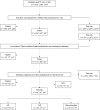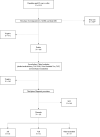Secular trends in the prevalence of dementia based on a community-based complete enumeration in Japan: the Nakayama Study
- PMID: 35753054
- PMCID: PMC9541546
- DOI: 10.1111/psyg.12865
Secular trends in the prevalence of dementia based on a community-based complete enumeration in Japan: the Nakayama Study
Abstract
Background: The number of dementia patients is increasing worldwide, especially in Japan, which has the world's highest ageing population. The increase in the number of older people with dementia is a medical and socioeconomic problem that needs to be prevented, but the actual situation is still not fully understood.
Methods: Four cross-sectional studies on dementia were conducted in 1997, 2004, 2012, and 2016 for complete enumeration of all residents aged 65 years and older. We examined the secular trends in the prevalence of all-cause dementia, Alzheimer's disease (AD), vascular dementia (VaD), and other/unclassified dementia.
Results: The age-standardised prevalence of all-cause dementia significantly increased (4.5% in 1997, 5.7% in 2004, 5.3% in 2012, 9.5% in 2016; P for trend <0.05). Similar trends were observed for AD (1.7%, 3.0%, 2.5% and 4.9%, respectively; P for trend <0.05) and other/unclassified dementia (0.8%, 1.0%, 1.0% and 2.2%, respectively; P for trend <0.05), whereas no significant change in VaD was seen (2.1%, 1.8%, 1.8%, 2.4%, respectively; P for trend = 0.77). The crude prevalence of all-cause dementia and AD increased from 1997 to 2016 among participants aged 75-79 years and ≥85 years (all P for trend <0.05). Similar trends were observed for other/unclassified dementia among participants aged ≥80 years (all P for trend <0.05), but not in VaD.
Conclusions: The prevalence of dementia has increased beyond the ageing of the population, suggesting that factors in addition to ageing are involved in the increase in the number of older people with dementia. To control the increase in the number of older people with dementia, elucidation of secular trends in the incidence, mortality, and prognosis of dementia as well as the factors that promote and protect against dementia, and development of preventive strategies are necessary.
Keywords: complete enumeration; dementia; prevalence; secular trends.
© 2022 The Authors. Psychogeriatrics published by John Wiley & Sons Australia, Ltd on behalf of Japanese Psychogeriatric Society.
Figures



Similar articles
-
Trends in dementia prevalence, incidence, and survival rate in a Japanese community.Neurology. 2017 May 16;88(20):1925-1932. doi: 10.1212/WNL.0000000000003932. Epub 2017 Apr 19. Neurology. 2017. PMID: 28424272
-
Trends in prevalence of Alzheimer's disease and vascular dementia in a Japanese community: the Hisayama Study.Acta Psychiatr Scand. 2010 Oct;122(4):319-25. doi: 10.1111/j.1600-0447.2010.01587.x. Epub 2010 Jul 9. Acta Psychiatr Scand. 2010. PMID: 20626720
-
Increased prevalence of vascular dementia in Japan: a community-based epidemiological study.Neurology. 2001 Sep 11;57(5):839-44. doi: 10.1212/wnl.57.5.839. Neurology. 2001. PMID: 11552014
-
Prevalence of dementia and major dementia subtypes in the Chinese populations: a meta-analysis of dementia prevalence surveys, 1980-2010.J Clin Neurosci. 2012 Oct;19(10):1333-7. doi: 10.1016/j.jocn.2012.01.029. Epub 2012 Jun 8. J Clin Neurosci. 2012. PMID: 22682650 Review.
-
A review of the epidemiological transition in dementia--cross-national comparisons of the indices related to Alzheimer's disease and vascular dementia.Acta Psychiatr Scand. 2001 Jul;104(1):4-11. doi: 10.1034/j.1600-0447.2001.00210.x. Acta Psychiatr Scand. 2001. PMID: 11437743 Review.
Cited by
-
Emerging trends in cognitive impairment and dementia among older populations in Asia: A systematic review.J Glob Health. 2024 Nov 8;14:04233. doi: 10.7189/jogh.14.04233. J Glob Health. 2024. PMID: 39513289 Free PMC article.
-
Donanemab in Japanese Patients with Early Alzheimer's Disease: Subpopulation Analysis of the TRAILBLAZER-ALZ 2 Randomized Trial.Neurol Ther. 2024 Jun;13(3):677-695. doi: 10.1007/s40120-024-00604-x. Epub 2024 Apr 6. Neurol Ther. 2024. PMID: 38581616 Free PMC article.
-
Blood RNA transcripts show changes in inflammation and lipid metabolism in Alzheimer's disease and mitochondrial function in mild cognitive impairment.J Alzheimers Dis Rep. 2024 Dec 23;8(1):1690-1703. doi: 10.1177/25424823241307878. eCollection 2024. J Alzheimers Dis Rep. 2024. PMID: 40034360 Free PMC article.
-
Cognitive Impairment and Brain Atrophy in Patients with Chronic Kidney Disease.J Clin Med. 2024 Feb 28;13(5):1401. doi: 10.3390/jcm13051401. J Clin Med. 2024. PMID: 38592226 Free PMC article. Review.
-
Charting Alzheimer's Disease and Dementia: Epidemiological Insights, Risk Factors and Prevention Pathways.J Clin Med. 2024 Jul 13;13(14):4100. doi: 10.3390/jcm13144100. J Clin Med. 2024. PMID: 39064140 Free PMC article. Review.
References
-
- Bhatt J, Comas Herrera A, Amico F et al. Alzheimer's Disease International. World Alzheimer Report 2019: Attitudes to Dementia. London, UK: Alzheimer's Disease International, 2019. [Accessed 21 Jan 2022.] Available from. https://www.alzint.org/u/WorldAlzheimerReport2019.pdf
-
- Statistics Bureau, Ministry of Internal Affairs and Communications, Government of Japan, 2021, Annual report of population estimates (in Japanese). [Accessed 21 Jan 2022.] Available from https://www.stat.go.jp/data/jinsui/pdf/202201.pdf
-
- United Nations . World Population Prospects: the 2019 Revision. New York: United Nations, Department of Economic and Social Affairs, Population Division, 2019. https://population.un.org/wpp/Publications/Files/WPP2019-Wallchart.pdf.
MeSH terms
Grants and funding
LinkOut - more resources
Full Text Sources
Medical

